What fertilizers to apply in the fall after harvesting potatoes
Potatoes only at first glance seem easy to care for. In fact, this is a very capricious crop with serious requirements for soil quality. To satisfy all the whims of the plant, you will have to take care of soil fertility in advance - literally immediately after harvesting.
We will tell you in detail what fertilizers to apply in the fall when digging for potatoes.
Why is it so important to fertilize the soil for potatoes in the fall?
Fertilize the soil immediately after harvest it is necessary to restore its fertility, because the formation of green mass and tubers takes a lot of nutrients.
During the autumn-winter period, organic matter has time to rot, and mineral fertilizers partially decompose, forming easily digestible compounds. This is the right time to disinfect the soil and normalize its acid-base balance. Less fertilizers need to be added to the soil prepared in the fall, and their effect will be stronger.
Soil preparation

Potatoes are demanding on soil fertility and love a thick layer of humus. To ensure such conditions, organic trenches begin to be prepared in the fall. This method allows you to get maximum yield even in small areas, because the plant roots receive natural heat, drainage and nutrition.
How to Prepare Organic Potato Trenches
Dig grooves 35-40 cm deep and wide. A passage of 60-80 cm is left between the trenches.
Organic waste is placed at the bottom of each groove: flower stems, weeds, mown grass, pumpkin tops, fallen leaves. Sprinkle earth on top. To speed up decomposition and enrich the soil with beneficial bacteria, microbiological preparations are used - “Shine”, “Vostok”, “Baikal”.
In a few months, organic matter has time to ferment, and the soil becomes looser and more nutritious.
Autumn feeding rules
Autumn soil preparation for planting potatoes includes:
- cleaning the area from tops and weeds;
- soil leveling;
- sowing green manure;
- digging up the soil;
- application of organic and mineral fertilizers.
Soil preparation
To begin with, the area is cleared of tops. The green mass of nightshades (potatoes, tomatoes, peppers and eggplants) is burned, the tops of cucumbers and zucchini can be sent to a compost pit, after watering with a lime solution - 1 kg of substance per 10 liters of water.
Weed residues are potentially dangerous for the future harvest. In addition to the fact that they shade the area and consume nutrients from the soil, weeds attract pests (wireworm) and can be carriers of diseases. To get rid of rhizomes, the field is plowed or manually dug. Additionally, the soil can be treated with herbicides.
They dig up the soil to increase its water and air permeability, saturate it with oxygen and get rid of the larvae of pests hidden in the lower layers of the soil. Sometimes two autumn diggings are required with an interval of 30-45 days, especially if the soil is too heavy.
Organic fertilizers
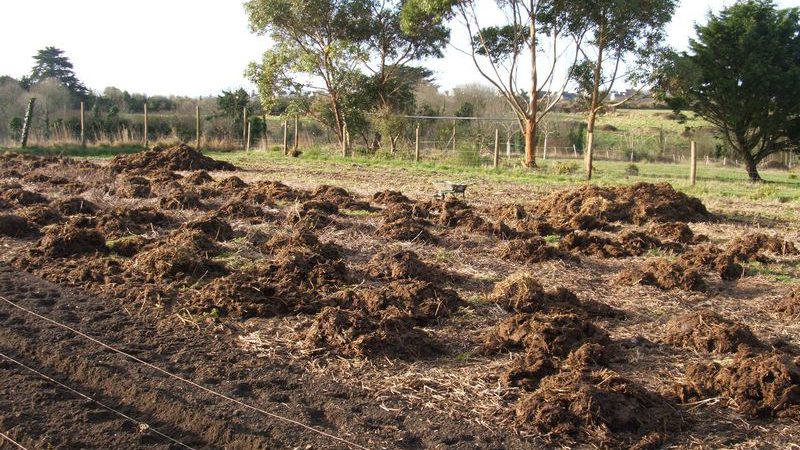
The most popular organic materials are manure, compost and ash. The micro- and macroelements in them are balanced by nature itself and are easily absorbed by plants.
In order not to attract pests preparing for winter that flock to the heat generated by manure, it is better to apply it in late autumn, after the first frost, after mixing it with compost. In addition to the usual mullein, you can use horse and rabbit manure. Pork preys for up to 18 months, so it is added only in exceptional cases.
Fresh wood recently cleaned from livestock is not suitable for autumn digging, as it contains seeds of weeds that will sprout in the spring.
Attention! Avoid fertilizing with organic matter if the soil is contaminated with potato nematode.
Minerals and green manures
In the fall, substances are introduced that dissolve more slowly and are not washed out of the soil longer:
- "Nitroammophoska";
- urea;
- "Superphosphate".
Follow the general rule: it is better to slightly underfeed potatoes than to allow an excess of nutritional compounds. For example, manure reduces the rate of mineral nitrogen preparations; “Superphosphate” is not mixed with urea. You should be careful when combining inorganics with ash.
How to fertilize the soil for potatoes in the fall without using special means? A gentle way to enrich the soil is to sow it with green manure. These plants are not grown for harvest, but as organic fertilizer. Green manure does not allow weeds to develop, protects the soil from dehydration and weathering, and prevents deep freezing of the soil.
Mustard, rye, rapeseed and phacelia are optimal for potatoes - they sprout quickly and gain mass.
Normalization of acidity
With the help of fertilizers, you can even out the pH of the soil: acidify the alkaline soil with leaf compost or peat, lime the acidic soil with ash.
To determine acidity, different methods are used:
- Pay attention to wild vegetation.Strongly acidic soils are preferred by plantain, pansy, horse sorrel and horsetail, while neutral and slightly acidic soils are preferred by clover, nettle, field bindweed, and coltsfoot.
- Check the reaction to vinegar. Soil with a neutral pH will bubble up.
- Use commercial strips to test acidity.
Types of fertilizers
Fertilizers have special properties and must be applied to the soil in certain quantities and combinations. We offer options for fertilizing potatoes in the fall.
Cow dung
The advantages of mullein are high nutritional value, availability and relative cheapness. You can agree on the supply of cow manure at almost any farm or farmstead.
The chemical composition of cow manure includes a large amount of nitrogen (especially bedding mullein with rotted remains of straw and hay), phosphorus, potassium, calcium and magnesium.
According to the degree of decomposition they are distinguished:
- fresh,
- half-rotted, obtained after 3-4 months storage;
- humus, the formation of which takes 6-12 months.
Fresh manure is rich in ammonia and often contains worm eggs and other pathogenic microflora. To get rid of parasites, mullein is composted or infused. The temperature inside the compost heap reaches 65°C, and helminth eggs die, and the percentage of weed germination decreases. That's why The half-rotted type is considered the most valuable – such biomass is loose and small, it contains a lot of nutrients.
Humus looks like a homogeneous, dark mixture with a distinct earthy odor. It is good for growing seedlings, mulching and as a filler for holes during and after planting.
Reference. It is usually recommended to apply 5 kg of manure per 1 m², but these norms are acceptable if fertilizing is done once every 3-4 years. When applying fertilizer annually, 500 g to 1 kg is sufficient, depending on the type of soil.
Bird droppings
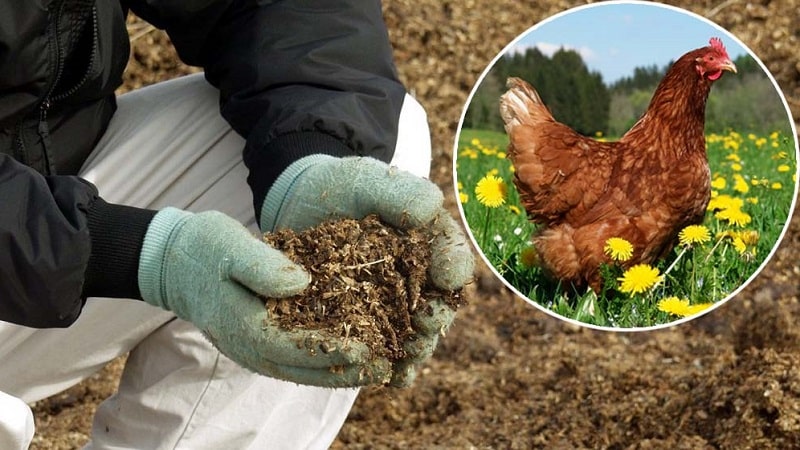
Chicken droppings are most effective as a fertilizer for potatoes, because they are less watery than the excrements of other poultry. This is a strong and fast-acting remedy, so it must be used with caution.
Benefits of fertilizer:
- bird droppings contain 3 times more nitrogen and phosphorus than cow droppings, and contain potassium in the form of highly soluble salts, manganese, sulfur, etc.;
- has a prolonged effect, so it is enough to apply it once every 2-3 years;
- increases crop resistance to late blight, scab, root rot and other infectious diseases.
Composted chicken manure is added to the soil for potatoes. To do this, it is sprinkled with plant residues, peat and soil and left to ripen throughout the summer. The application rate per 1 m² is 500-700 g of litter.
Reference. Specialized stores sell dried and sterilized chicken manure products in the form of granules, balls and powder. They are safer than fresh fertilizer.
Compost
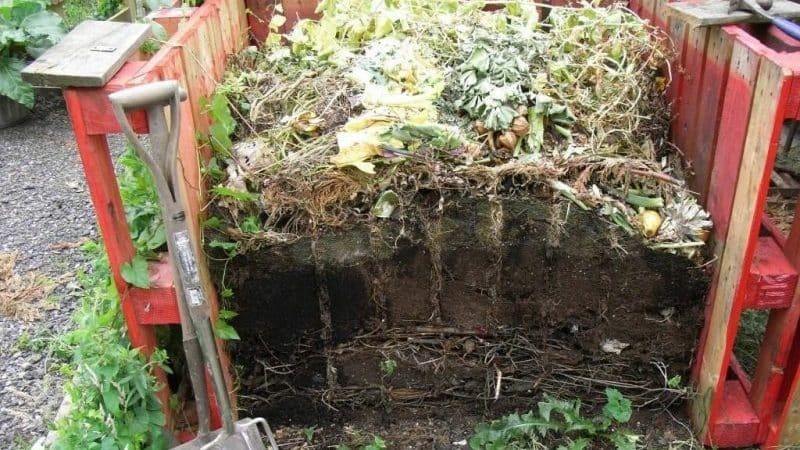
This natural breakdown product is the most affordable fertilizer, because you can make it yourself from almost any organic waste: leftover food, straw and hay, sawdust, tops of root crops. To speed up ripening, special catalyst substances are added to the compost, and mineral additives are added to enrich the composition.
Attention! In order not to make the compost pit a breeding ground for fungal and bacterial diseases, you should not put nightshade tops (potatoes, tomatoes, eggplants, peppers), apples, or spoiled bread in it. Fruits with large stones and weeds with seed pods and roots should be avoided.
Half-rotted compost is suitable for autumn digging; over the winter, the remains will have time to completely decompose. It is applied according to the principle of a layer cake, alternating with manure, straw or fresh mown grass, and 10-15 cm of ordinary soil is poured on top and watered with water or a solution of microbiological fertilizers.
Wood ash
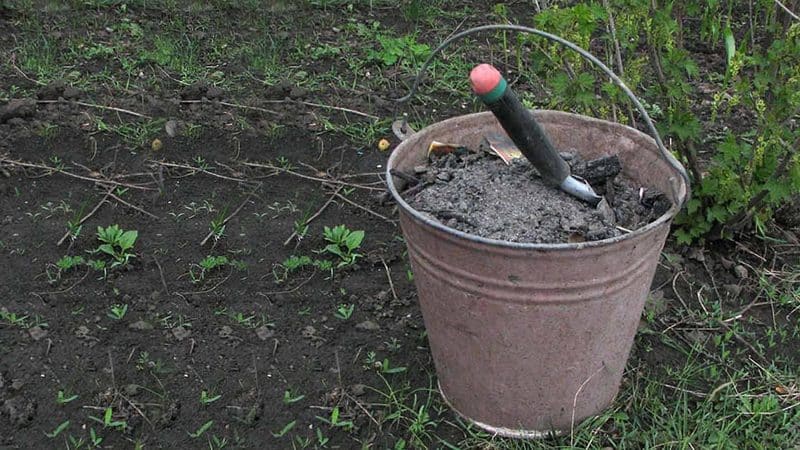
The main purpose of this fertilizer is to alkalize acidic soils and increase plant resistance to disease.
The composition largely depends on the initial raw materials:
- straw ash, especially after burning sunflower and buckwheat stalks, leads in potassium content - 25-35%;
- ash from birch and pine firewood is the richest in calcium - 30-40%.
Other nutrients include phosphorus in easily digestible form, manganese, magnesium, sulfur, boron, iron, molybdenum.
Ash should not be used simultaneously with nitrogen fertilizers, such as manure, as it activates the activity of nitrogen-fixing bacteria. Its best “companions” are humus (compost) and peat.
The long-term effect of adding ash is especially noticeable on heavy clay soils, but it is washed out faster from sandy soil.
Reference. Ash is used in crumbly form and as a solution - 100-150 g per 10 liters of water. In autumn, apply 60-100 g of fertilizer per 1 m² of soil.
Phosphorus fertilizers

The most popular phosphate fertilizers are:
- Phosphorite flour. Contains 19-30% calcium phosphate.Suitable only for podzolic and peaty soils and applied with acidic fertilizers, for example, ammonium sulfate or manure.
- Simple and double “Superphosphate” include 16-20% and 43-46%, respectively, of water-soluble calcium phosphate. Can be used on all types of soil.
- Combined fertilizers – "Nitrophoska" and "Nitroammofoska". They also contain nitrogen and potassium.
For autumn soil preparation for potatoes, choose “Nitroammophoska” (30 g per 1 m²), as well as simple (20 g) or double (10 g) “Superphosphate” in combination with nitrogen and potassium fertilizers.
Important! Phosphates work better in tandem with potassium fertilizers, so they need to be applied at the same time.
Urea
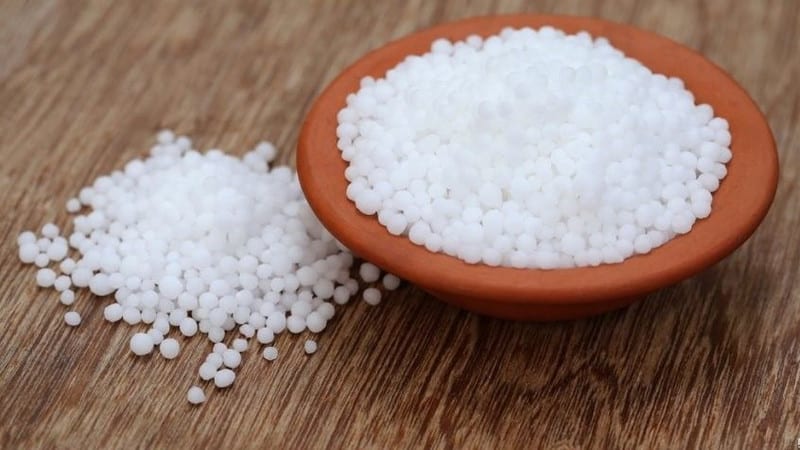
The academic name of the fertilizer is urea. Used in agriculture since the 18th century to enrich the soil with nitrogen.
Urea is highly soluble in water, but is not washed out of the soil by precipitation, so it requires careful use. Most often, such fertilizer is applied inside the hole when planting tubers, and then in the form of root and foliar dressings during the summer. In autumn, it is used immediately after harvesting to avoid the formation of harmful compounds at low temperatures.
This is interesting:
How to fertilize cucumbers with mullein.
Rules for feeding cucumbers with chicken droppings in open ground and greenhouses.
Fertilizing tomatoes with urea: why it is needed and how to do it.
Nitrate fertilizers
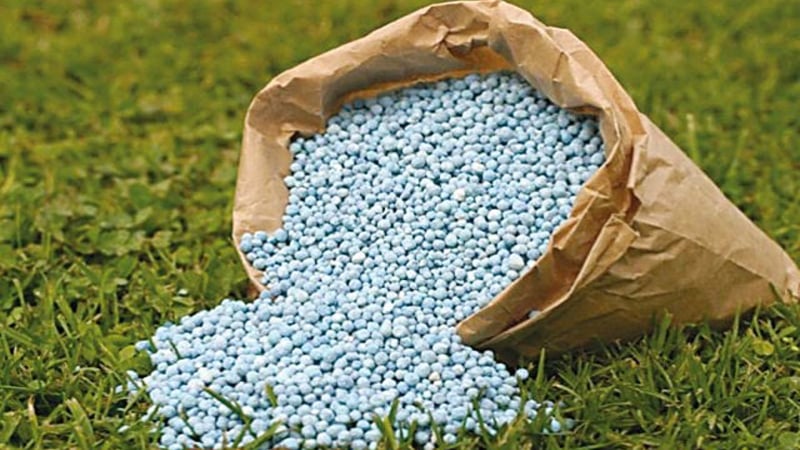
Nitrates contain nitrogen in the form of nitric acid - nitrates, they quickly dissolve in the soil. In the fall, after harvesting, sodium nitrate is used primarily as a fertilizer for potatoes.
The disadvantage of such fertilizers is that they are quickly washed out of the soil., therefore it is recommended to apply them in the spring, shortly before sowing.
Reference. Nitrate fertilizers are physiologically alkaline, therefore they are effective on acidic soddy-podzolic soils, and should be avoided on saline soils and solonetzes.
Ammonia fertilizers
These include:
- ammonium nitrate in granules;
- aqueous ammonia, or ammonia water;
- nitrogen-phosphorus fertilizers - “Ammophos” and “Diammophos”.
Nitrogen in ammonia (ammonium) form is highly soluble in water and quickly absorbed by plants. It evaporates just as quickly from the soil, so ammonia substances are introduced into the soil to a depth of 3-4 cm and sealed.
Potash

Potatoes love potassium, but not all potassium fertilizer formulas are equally beneficial for the crop.
Potassium chloride slows down plant growth and reduces the amount of starch in tubers, so it is better to choose sulfate forms for fertilizing. But if you apply chlorine-containing potassium fertilizers in the fall, they will disinfect the soil and be partially washed out of it by spring, without harming the plantings.
Potassium sulfate (potassium sulfate) enriches the soil with sulfur and has a positive effect on the keeping quality of tubers. However, this form is not suitable for neutral and alkaline soils.
Rules for selecting fertilizers for different types of soil
The main characteristics of the soil are the presence of humus, soil structure and acidity. To answer the question of how to fertilize a potato field in the fall, you must first determine the type of soil.
Clay soil
Clay soils are heavy and dense, they warm up slowly, do not allow moisture to pass through well and, as a rule, have an acidic environment. Such properties have a bad effect on the potato harvest.
Liming helps reduce acidity. To do this, slaked lime or “fluff”, dolomite flour, wood ash, ground chalk and crushed eggshells are added to the soil in the fall.When using lime, additional fertilizer with manure will be ineffective, so fertilizing with organic matter is postponed until spring.
To make the soil more air- and water-permeable, loosening materials are added: sand, light leaf humus, peat at the rate of 1 bucket per 1 m².
Loam
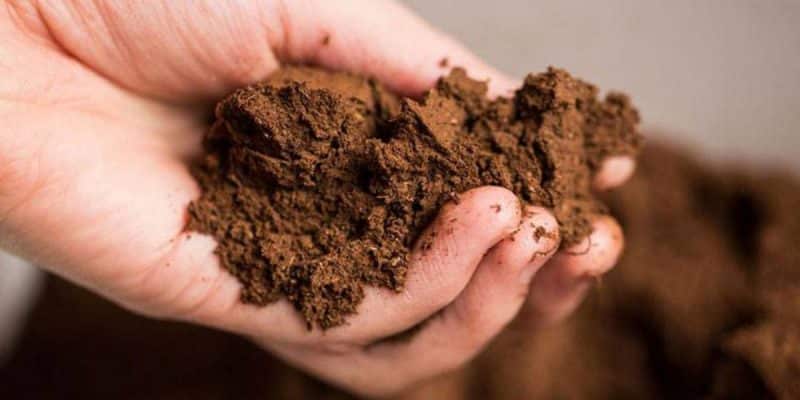
This type of soil is distinguished by:
- granular-lumpy structure;
- sufficient amount of nutrients;
- high level of water permeability and breathability.
Despite the presence of heavy and dense clods in the soil, loam is favorable for the cultivation of vegetable crops.
To maintain optimal conditions, loamy soils need to be enriched with organic matter - compost and manure - in the fall. Sodium nitrate is an effective mineral fertilizer.
Sandy
The main disadvantage of sandy soils is that they are poor in humus (humus content is about 1%), do not retain moisture well, overheat during the day and cool quickly at night. But this loose soil is easy to process.
To get a good potato harvest, compacting components are added to sandy soils: peat, clay flour and compost. Once every 2 years, rotted manure is placed in the deep layers. Potassium magnesium (potassium magnesium sulfate) helps compensate for the lack of magnesium.
Reference. Organic and mineral fertilizers must be applied regularly, as they quickly decompose in sandy soil.
Chernozem
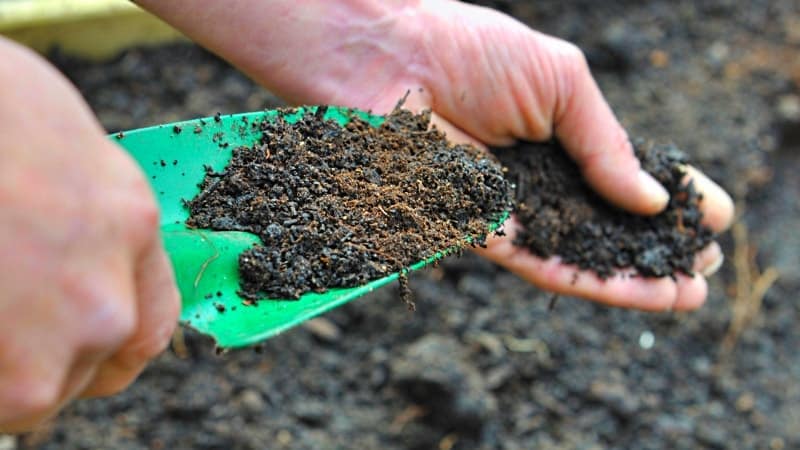
Chernozem is rich in humus (up to 15%), permeable to air and moisture. Due to the high calcium content (70-90%), the soil reaction is neutral or close to neutral. Such soil has natural fertility, so it can be used as a fertilizer in itself.
If the chernozem is of low quality (only 4% humus) or the soil is depleted, it can be additionally fed with nitrogen and phosphorus fertilizers - potassium sulfate or ammonium sulfate. Once every 5-6 years it is useful to give the soil a “rest” by sowing green manure.
What fertilizers should not be applied to potatoes in the fall?
For the winter, you cannot apply fertilizers that:
- contain spores of pathogenic microorganisms - fresh manure, compost from infected tops and weeds;
- disrupt the balance of micro- and macroelements in the soil.
When combining various fertilizers, you should not mix some substances:
- alkaline media (ash, lime, chalk) reduce the effectiveness of nitrogen fertilizers (ammonium nitrate, ammophos, ammonium sulfate);
- manure contains a lot of nitrogen, so it does not require additional application of nitrogen-containing substances;
- ammonium nitrate in combination with dry organic matter (peat, straw, sawdust) can lead to spontaneous combustion.
The most common mistakes when applying autumn fertilizers:
- soil pH is incorrectly determined;
- the dosage is violated;
- expired fertilizers are used;
- Recommendations for combinations of substances are not followed.
Conclusion
An experienced gardener knows that dacha work does not end with harvesting. In order for the next season to be successful, you need to properly fertilize the soil for future plantings. To do this, it is important to determine the type of soil, acidity, select the fertilizer necessary for the soil and select fertilizers that combine with it.